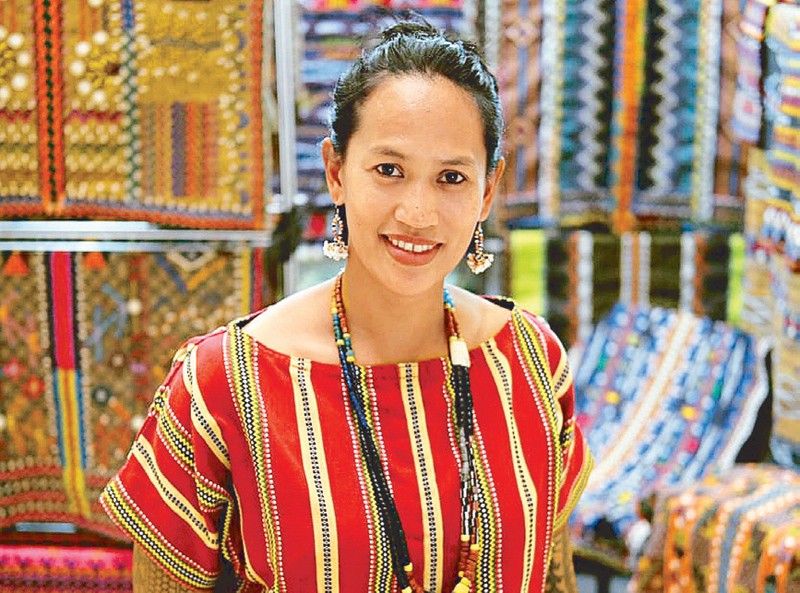Healer at the Loom


Part of our precolonial identity — sustained unbroken through generations — is deeply interwoven in the many weaving cultures of the archipelago, with each having its own vocabulary of forms, motifs and patterns inflected with their individual meanings and roles in the community. Particularly rich in tradition is the Kalinga Province, whose stories Irene Bawer-Bimuyag tells through a collection of textile art creations in the show, “Palin-awa: Sacred Ritual Healing Amongst Kalingas,” which opened at Boston Gallery Sept. 12.
Hailing from Mabilong, Lubuagan, the backstrap weaving center of Kalinga, the artist has always rooted herself in the community, keenly aware of how her works embodies a fierce sense of place and a reckoning with tradition. Though this is the first time that her works are exhibited within the context of a solo exhibition, Bawer-Bimuyag has been presenting her intricate, handwoven pieces in different venues, such as the group shows “Walong Filipina” (2015) at Liongoren Gallery and “Everyday Objects” (2012) at BenCab Museum. Since 2014, she has been participating in Likhang Habi, the foremost textile fair in the Philippines.
In “Palin-awa,” Bawer-Bimuyag introduces the viewers to the healing symbols and rituals of Kalinga, where she continues to live and practice her craft. A third-generation weaver, Bawer-Bimuyag involves a community of women weavers who use the backstrap loom to articulate her designs, starting with the making of tapis, the traditional wraparound skirt, as the canvas. She then embellishes the cloth with embroidery, guided by her heritage and her own intuition, transforming it into a vessel that gathers together — in weft and woof — myth, memory, and magic.
No two works by the artist are ever the same. In fact, no design is ever set on paper. Bawer-Bimuyag communicates her visual ideas clearly and directly to the weavers who, sharing a collective grammar of motifs, translate them into dazzling patterns that evoke the repetition of the rice terraces, the deep colors of the natural world, the recognizable forms of flora whose healing and efficacious properties have long been part of the shared knowledge of the community.
Her intuitive sense of creativity is what infuses her works with an otherworldly, hypnotic quality, as the geometric and organic shapes dazzle the eye. Concentric circles seem to rotate and expand; rice stalks bristle in the invisible wind; zigzag formations achieve a kind of rhythmic pulse. While delightfully symmetrical at first look, the tapestries feature breaks in the patterns upon closer inspection, allowing room for subtle and mindful chance.

The illusion of movement in the tapestries is a tradition centuries older than the artistic movement Op Art, and more resonant: it is embedded in the everyday life of the people, as common as the stalks loaded with grains and tattoos on the skin of both young and the old in the northern province. What has begun as a piece of cloth is now a world teeming with the most vibrant of hues, the lush forms of the landscape, and the symbols imbued with talismanic power.
Each tapestry is the distillation of hundreds of years of wisdom as well as a novel approach in telling the story of Kalinga through the fresh and startling combination of colors and patterns, touching delicately upon Bawer-Bimuyag’s exposure to other weaving traditions. Her artistry, while grounded in her own locality, is also informed by the places she has traveled, from Asia to Europe to North America. What she wants to achieve is not merely a recreation of a template but a living text (the root word of “textile”) that is conversant with the contemporary world, rich in possibilities and associations.
“Palin-awa,” which denotes the culmination of a healing ritual, is an invitation to participate in the restorative properties of what the human hands have been quietly and generously accomplishing for centuries as a way to make sense, record, and participate in the natural world whose capacity for healing is incalculable. Our connection to this world, the tapestries remind us, is ever-rooted and ever-nourished, as energetic and as vital as the shuttle crisscrossing through a rainbow of threads, uniting and keeping them in place.
* * *
Boston Gallery is located at 72 Boston St., Cubao, Quezon City. For details, email thebostongallery@yahoo.com or call 0917-5490545.



















